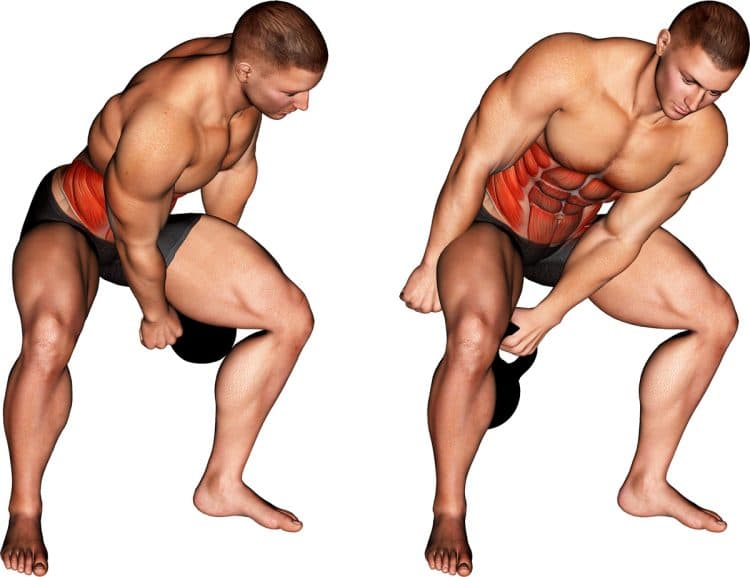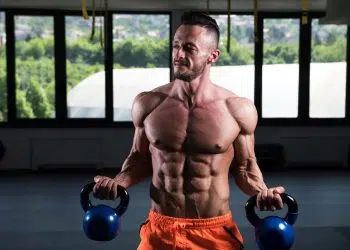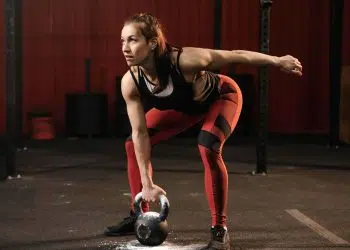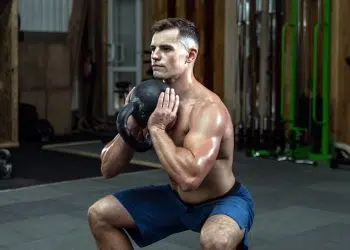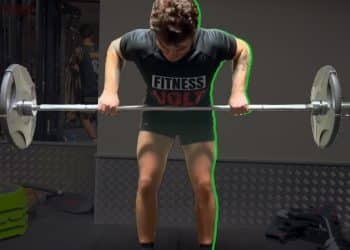The kettlebell figure 8 is a variation of the kettlebell swing that involves swinging a kettlebell in between and around the legs in a figure 8 motion. There are many benefits to doing this exercise including that it involves a dynamic hip hinge swing motion which is the basis of many kettlebell lifts.
Therefore, it does require you to have some mobility but also flexibility and coordination as you have to change hands as you’re performing the exercise. We really like the figure 8 because it changes things up but also helps you to improve many aspects of performance and functional fitness.
Keep reading to learn about the muscles it works, how you should be doing it, a deeper dive into its benefits, and more.
In This Exercise:
- Target Muscle Group: Legs, back, obliques, rectus abdominis
- Type: Functional fitness, strength
- Mechanics: Isolation
- Equipment: Kettlebell
- Difficulty: Intermediate
Muscles Worked
The kettlebell figure 8 works several muscles in the lower, and upper body and it’s a core killer too. We’ve included brief descriptions of their anatomy and function.
Core
Kettlebell figure 8s are a core blaster that’ll have your abs, obliques, and back extensors working overtime to stabilize the trunk, rotate the torso and bend in different directions repeatedly.
Level Up Your Fitness: Join our 💪 strong community in Fitness Volt Newsletter. Get daily inspiration, expert-backed workouts, nutrition tips, the latest in strength sports, and the support you need to reach your goals. Subscribe for free!
Gluteus Maximus
A massive muscle of the butt, your gluteus maximus is the largest formation of the glute and hips. It’s job is to extend and externally rotate the thigh. You’ll use your glutes a lot during kettlebell figure 8s.
Quadriceps
The quadriceps are a big and strong group of five muscles on the front thigh despite the name “quad”. Big quad muscles are the result of performing exercises that involve hip flexion and knee extension such as squat type movements.
Hamstrings
If you reach down and touch the back of your thigh between the knee and butt, you’ll feel the three hamstrings muscles – semitendinosus, semimembranosus, and biceps femoris. These muscles are responsible for hip extension and knee flexion.
How To Do The Kettlebell Figure 8
With movements such as the figure 8 and other kettlebell exercises that require a little skill and experience, you need to make sure it’s being performed correctly for your safety and to ensure you’re getting the benefits from it.
It’s important to note that there are two common ways to perform this exercise including the kettlebell swing and squat variations.
We’ve provided step-by-step instructions for how to perform the movement below.
- Set the kettlebell on the floor with the handle positioned diagonal depending on which side you’ll start from. Grab only half of the kettlebell handle at the part that is furthest from you. This way when you pass the handle between your legs, your other hand can grab the other part of the handle.
- Stand close to the kettlebell with feet roughly shoulder-width apart.
- Bend at the knees, hinge at the hips with the back flat and rounded, tighten your core, then pick up the kettlebell as explained in step 1.
- Swing the weight between your legs toward the opposite arm and grab the handle using the empty hand.
- Swing the bell around the outside of the leg, straighten your legs and snap your hips forward. The arm should swing the kettlebell forward slightly.
- Swing the kettlebell back between the legs toward the opposite arm, grab it using the empty hand and repeat this process.
Squat variation
To do the squat variation of the kettlebell figure 8, squat down, grab the kettlebell with one hand, pass it through your legs, grab it with the other hand and stand up. Then, squat back down, pass it through, grab it using the other hand, and stand back up. Repeat this until your set is complete.
Here’s a video tutorial that shows both variations.
Kettlebell figure 8 tips/what not to do
- The exercise should happen in one fluid motion. You don’t want to do jerky movements or pause at any point during the exercise.
- A mistake that beginners will often make is allowing their backs to round and not keeping a tense core. This can stress the lower back and is not good for postural health. Start with a light weight and practice good form before using more weight. Gradually increase the poundages as you get stronger.
Benefits
There are some benefits to doing this exercise that we think are worth learning about so that you may consider how functional and effective this movement is.
Works posterior chain and core muscles
Kettlebell hinge movements are some of the best for working the posterior chain or backside of the body. These muscles include the hamstrings, glutes, back and rear deltoid muscles. But the core muscles also get hammered during this movement as they play a big role in total body functional activities such as this one.
And because you’re on your feet, this exercise will have a lot of carryover to everyday activities and athletic movements.
Burns fat and improves conditioning
Because you’re constantly moving during this exercise, it’s going to burn more calories. If you’re looking to get stronger, fitter, and leaner, the figure 8 can help in combination with a proper fat loss diet.
Additionally, the constant movement is going to build up your cardiovascular endurance and conditioning to make you a better athlete. Although, you certainly don’t need to be an athlete to benefit from the kettlebell figure 8.
Good for strengthening posture
Hip hinge exercises such as deadlifts, kettlebell swings, etc, are all really good for strengthening your upper rear muscles that play an important role in posture. The muscles of the backside are often neglected by those who aren’t as informed and as a result they weaken.
Well, this negatively affects posture, lifting performance and how you feel overall.
Great for training hip hinge
Learning to properly hinge from your hips using good posture is essential for things like deadlift variations, bent-over rows, picking up weights from the floor, bending over and picking up objects, and this position allows us to generate a lot of force and power.
If you want to be fit, athletic, and even competitive in your chosen sport, then you must get good at this movement – it’s simply non-negotiable.
Related: 6 Hip Hinge Exercises Guaranteed to Maximize Lower Body Power and Mobility
Total-body stability
The kettlebell figure 8 requires total body stability and even more so when swinging around a heavy weight. You’re not just swinging the weight forward and backward as it’s a multiplanar movement that also challenges side-to-side or lateral stability.
Level Up Your Fitness: Join our 💪 strong community in Fitness Volt Newsletter. Get daily inspiration, expert-backed workouts, nutrition tips, the latest in strength sports, and the support you need to reach your goals. Subscribe for free!
This type of training is not only good for sport, but also balance and total-body awareness. As we get older, this becomes even more crucial even for performing everyday tasks.
Prevent injuries
To continue from the previous benefit, training your body to improve balance, coordination, stability and awareness is going to carry over into preventing injuries. Again, this is especially beneficial for older people. But if you’re an athlete, the functional and total-body benefits are worth including it in your workout routine.
Drawbacks
There are a few drawbacks to this movement.
Can take a little time to get it right
While we certainly do not feel the kettlebell figure 8 is a very complex movement, it’s not the simplest either. Unlike a bicep curl, there are more steps involved. Depending on which variation you do, be sure to have a checklist of form ques that you need to pay attention to.
Can be tempting to use bad form
Exercises such as this one that involve a little more complexity combined with fluid movement may result in the temptation to neglect proper form. I mean you’re swinging a kettlebell around and exchanging it between hands.
This could certainly cause some lifters to forget about maintaining a flat back, especially with a kettlebell as opposed to a heavy loaded barbell or similar.
It doesn’t matter what kind of weight you use, technique should always be the first focus. Bad habits may not get you now but somewhere down the line you may pay for it.
Kettlebell Figure 8 Alternatives / Variations
The kettlebell figure is a great exercise for many reasons, however, we also like to share some similar exercises that you can do to mix up your training and get even more benefits. Keep in mind that there are tons of variations you can do, however, we can’t list them all. But here are some great versions of the exercise.
1. Alternating kettlebell swing
The alternating kettlebell swing involves a somewhat similar motion compared to the figure 8. You are swinging the kettlebell back and forth between the legs, however, in a single direction as opposed to a more circular motion. This variation may require a little more coordination and obliques.
Also check out these 12 Must-Do Kettlebell Exercises For Hypertrophy, Strength and Function
2. Kettlebell figure 8 to hold
This variation takes the figure 8 and adds an additional element to test the upper body muscles and coordination even more.
To do it:
- Using the same setup as explained in the basic kettlebell figure 8 instructions above, swing the kettlebell between and around the leg, grab it with the opposite hand, extend your knees and snap your hips forward, then catch the kettlebell at your chest. Hold the kettlebell with both hands in front of your chest.
- Swing the kettlebell through the legs, grab it with the other hand, extend the knees, snap the hips forward, and bring the kettlebell to the front rack position close to the chest and use the other hand to hold it there momentarily.
- Repeat his pattern until you’ve completed a set.
3. Kettlebell squat to overhead press and figure 8
This variation combines several movements in one exercise. It’s going to be a lot more challenging and you definitely need some stamina to do it. We recommend this exercise for those who have some experience with basic kettlebell training technique.
To do it:
- Perform a goblet squat.
- Stand up and press the kettlebell overhead.
- Bring the kettlebell back to the front rack position (hold it in front of the chest).
- Extend your arms down in front of you (starting position for the kettlebell swing).
- Perform a figure 8. During the last part of the figure 8 where you snap the dumbbell forward, catch it in the front rack position.
- Transition to the goblet squat and repeat the movement.
How To Incorporate The Kettlebell Figure 8 Into Your Training Regime
The kettlebell figure 8 is one of the best variations for functional fitness. Whether you’re a team sports athlete, train MMA, workout in a box, or your job requires you to be fit, this movement deserves a place in your routine.
Some of its best uses include:
Of course, you can also design your own workouts and have fun with it. There’s no perfect way to train or structure training programs, although having some sort of rhyme and reason to your exercise routine can make it more enjoyable and effective.
There are so many different variations and combinations of the kettlebell figure 8. You can incorporate squats, presses, and don’t be afraid to be a little creative. A simple way to incorporate it into your training is to set a timer, pick a challenging weight, and go until you’re done.
No Frills Fitness: One Kettlebell and Bodyweight Full-Body Workout
Try The Kettlebell Figure 8 To Mix Up Your Training and Get More Functional
If you’re into functional fitness then the kettlebell figure 8 is one must-have exercise that you need in your workout arsenal. It has incredible benefits and carryover to real-world application plus you’ll strengthen your posterior chain muscles and core.
Not to mention, if you like kettlebell training, it mimics the swing which many advanced movements stem from. It’s just all-around beneficial for everyone.
Another great thing about choosing this movement to include in your repertoire is that all you need is a dumbbell and a little space.
Interested in measuring your progress? Check out our strength standards for Goblet Squat, Deadlift, Hip Extension, and more.

